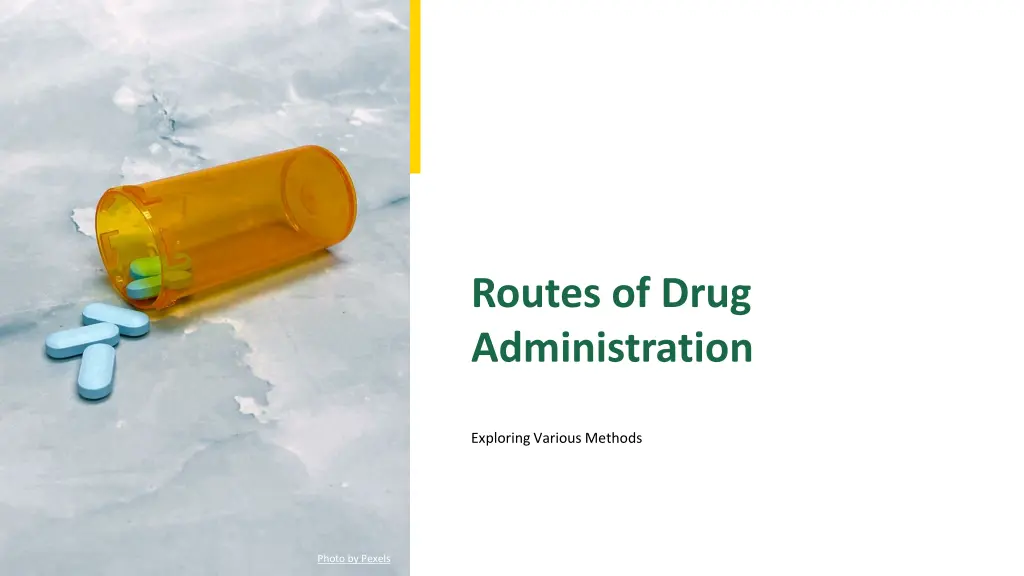
Exploring Drug Administration Methods for Optimal Therapy
Discover the diverse routes of drug administration, from oral to rectal, impacting onset, intensity, and duration of effects. Learn how healthcare professionals optimize patient care and medication efficacy through various delivery methods.
Download Presentation

Please find below an Image/Link to download the presentation.
The content on the website is provided AS IS for your information and personal use only. It may not be sold, licensed, or shared on other websites without obtaining consent from the author. If you encounter any issues during the download, it is possible that the publisher has removed the file from their server.
You are allowed to download the files provided on this website for personal or commercial use, subject to the condition that they are used lawfully. All files are the property of their respective owners.
The content on the website is provided AS IS for your information and personal use only. It may not be sold, licensed, or shared on other websites without obtaining consent from the author.
E N D
Presentation Transcript
Routes of Drug Administration Exploring Various Methods Photo by Pexels
01 Understanding Drug Administration Table of Contents 02 Oral Route 03 Injection Routes 04 Sublingual and Buccal Routes 05 Rectal Route 06 Vaginal Route 07 Ocular Route 08 Otic Route 09 Nasal Route 10 Thank You
1 Understanding Drug Administration The Basics Drug administration is the process by which a drug is delivered into the body for therapeutic effect. Routes of administration affect the onset, intensity, and durationof the drug's effect, making selection crucial. Understanding these routes helps health professionals optimize patientcare and medication efficacy. Let's explore the various routes in detail to appreciate their unique benefits and applications. Photo by Pexels
2 Oral Route Easy and Accessible The oral route involves taking medications by mouth, the most common method of drug delivery. It is non-invasive, easy to use, and suitable for self- administrationby patients. However, the absorption can be affected by various factors like food and gastrointestinal contents. Many drugs are formulated for this route, enhancing patient compliance and convenience. Photo by Pexels
3 Injection Routes Direct Delivery Injection routes include intravenous (IV), intramuscular (IM), and subcutaneous (SC) administration. These routes ensure rapid drug absorption and direct entry into the bloodstream. Injections are often used for drugs that cannot be given orally due to degradation in the digestive system. They are essential in emergency care and for vaccines, providing immediate therapeutic action. Photo by Pexels
4 Sublingual and Buccal Routes Fast Absorption Techniques The sublingual and buccal routes involve placing drugs under the tongue or between the gums and cheek. These methods allow for quick absorption directly into the bloodstream, bypassing the digestive tract. They are effective for certain medications like nitroglycerin and some hormones. These routes enhance the speed of therapeutic effect, offering convenience for acute conditions. Photo by Pexels
5 Rectal Route Alternative Option The rectal route is used when oral administration is not possible due to vomiting or unconsciousness. Medications are administered as suppositories or enemas, allowing rapid absorptioninto circulation. This route is effective for local treatments (like hemorrhoids) and systemic effects. Despite being less popular, it serves a vital role in specific patientconditions and scenarios. Photo by Pexels
6 Vaginal Route Targeted Applications The vaginal route involves the administration of medications directly into the vaginal canal. It is commonly used for treating infections and hormone therapies, ensuringlocal effects. This route promotes systemic absorption of certain medications, offering a dual benefit. Vaginal administration enhances patient comfort and adherence for specific female health needs. Photo by Pexels
7 Ocular Route Eye-Centric Therapy The ocular route delivers medications directly to the eye's surface or intraocularly. It is essential for treating conditions like glaucoma or infections with minimal systemic effects. Eye drops, ointments, and implants are common forms of ocular drug delivery. This targeted delivery maximizes effectiveness while minimizing systemic side effects. Photo by Pexels
8 Otic Route Ear Treatments The otic route involves administering medications into the ear to treat infections and inflammation. Ear drops are commonly used, providing localized treatment and quick relief. This route is particularly important in pediatric care for managing ear infections. Otic administration is effective for reducing discomfort and promoting healingin ear conditions. Photo by Pexels
9 Nasal Route Rapid Uptake The nasal route allows for quick drug absorption through the nasal mucosa into the systemic circulation. This route is beneficial for medications like pain relief or hormone therapies. Nasal sprays provide a user-friendly option for rapid relief without injections. The nasal route combines convenience and effectiveness, ideal for various therapeutic needs. Photo by Pexels
10 Thank You For Your Attention! Thank you for exploring the routes of drug administration with us today. Each route offers unique advantages, influencing patient outcomes and care quality. Remember, the choice of administration route is pivotal in medical treatments. We hope you gained valuable insights from this presentation! Photo by Pexels
